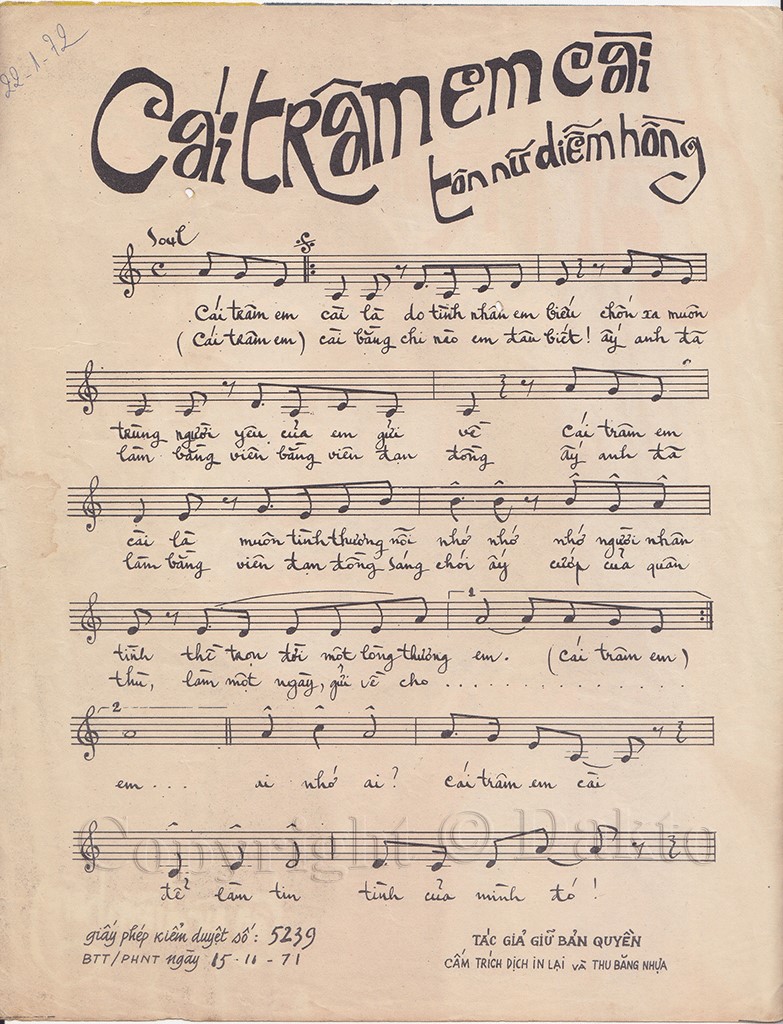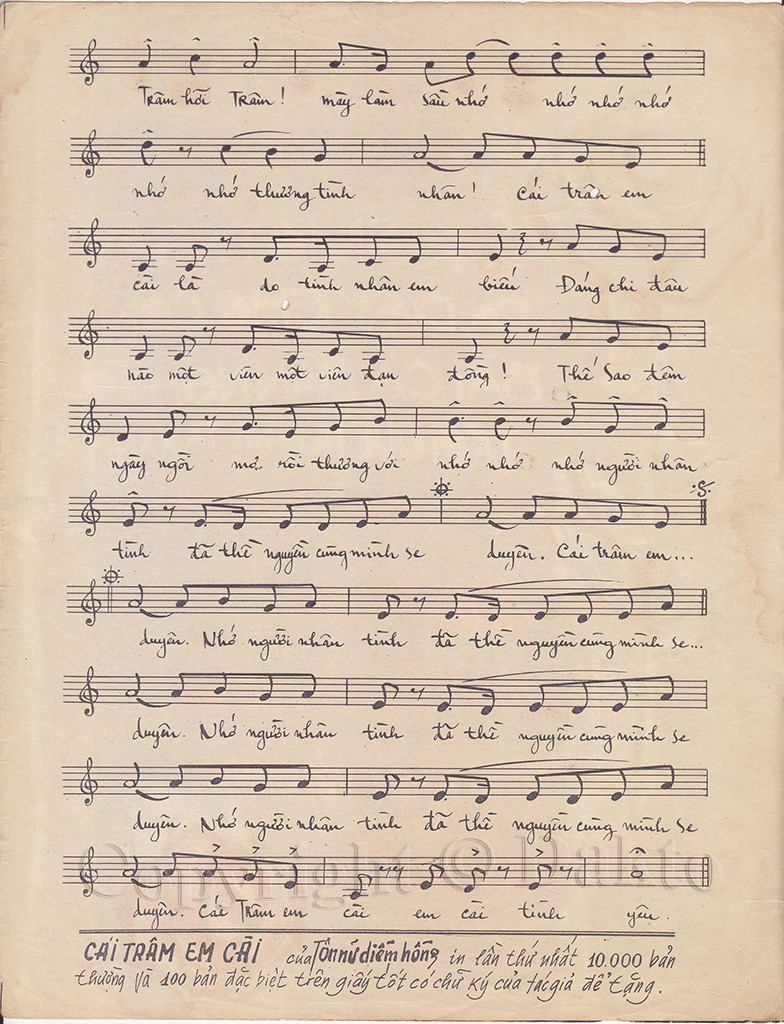Hoàng Thi Thơ’s “The Pin in My Hair” (“Cái trâm em cài,” 1971?) is a sweet song about a young woman whose boyfriend is away fighting, and she treasures the hairpin that he made for her as a memento of their love. The song was composed sometime in the early 1970s in the Republic of Vietnam (RVN, or South Vietnam) and is the third track on Saigon Rock & Soul. This post continues my series-within-a-series translating the lyrics of songs from that CD.
I wouldn’t describe “The Pin in My Hair” as an antiwar song, but it does acknowledge the burden that the war imposed on young lovers. In fact, war seems to heighten the sense of romance in the song. While such depictions of war and romantic love were common in the RVN, they were quite rare in the Democratic Republic of Vietnam (North Vietnam). The communist government discouraged young people from falling in love and marrying so as not to interfere with the war effort, and artists were supposed to produce songs that encouraged youth to serve in the war while downplaying the consequences. Thus, South Vietnamese songs like “The Pin in My Hair” may have been mostly apolitical, but they were nonetheless a testament to the greater artistic freedom that musicians and songwriters enjoyed in the RVN compared to communist North Vietnam.


This rendition of Hoàng Thi Thơ’s “The Pin in My Hair” is performed by Carol Kim. The software I am using does not allow for footnotes on some posts, so they appear below my translation but are not linked. Please note that the CD version does not follow the same ending as the sheet music. The sheet music repeats the last line in the third stanza several times before ending with a new line. I have omitted this alternative ending in the original lyrics and my translation to make it easier to for readers to follow this particular rendition of it.
CÁI TRÂM EM CÀI
Nhạc và lời của Hoàng Thi Thơ
Cái trâm em cài là do tình nhân em biếu (đó)
Chốn xa muôn trùng người yêu của em gởi về
Cái trâm em cài là muôn niềm thương nỗi nhớ
Nhớ nhớ người nhân tình thề trọn đời một lòng thương em.
Cái trâm em cài bằng chi nào em đâu biết!
Ầy anh đã làm bằng viên bằng viên đạn đồng
Ầy anh đã làm bằng viên đạn đồng sáng chói ấy
Cướp của quân thù, làm một ngày, gởi về cho em.
Điệp khúc:
Ai nhớ ai? Cái trâm em cài để làm tin,
Tình của mình đó! Trâm hỡi trâm!
Mầy làm sầu nhớ nhớ nhớ nhớ nhớ nhớ thương tình nhân!
Cái trâm em cài là do tình nhân em biếu (đó)
Đáng chi đâu nào một viên một viên đạn đồng!
Thế sao đêm ngày ngồi mơ rồi thương với nhớ
Nhớ nhớ người nhân tình đã thề nguyện cùng mình se duyên.
THE PIN IN MY HAIR
Music and lyrics by Hoàng Thi Thơ
Original translation by Nu-Anh Tran
The pin in my hair (here) is a gift from my lover
Sent by my sweetheart from far, far away
The pin in my hair holds untold love and yearning
Yearning, yearning for the lover that swore to love me for life with all his heart.
The pin in my hair – I didn’t know what it was made of!
Look, he made it from a bullet, a bullet of copper
Look, look, he made it from a gleaming copper bullet
That he stole from the enemy, then he spent a day making [the hairpin], and sent it home to me.
Chorus:
Who is yearning for whom? The pin in my hair is a pledge,
Our love is right there, see! Hairpin, oh hairpin!
You sadden me and make me yearn yearn yearn yearn yearn yearn for my lover!
The pin in my hair (here) is a gift from my lover
What’s it worth a bullet, a bullet of copper!
Then why do I sit and dream, love and yearn all day and night
Yearn, yearn for the lover that has sworn to join his destiny to mine.1
Notes
1se duyên (“to twine the fates of different people together”): This literary expression means “to marry or to arrange a marriage.” It is a reference to Nguyệt Lão (Ch. Yue Lao), a mythical old man who sits in the moonlight and sorts red threads into pairs. In some versions, he also ties or twines the threads together. Each pair represents a man and a woman who are destined to marry. Once he binds a couple together, it will be impossible for the two parties to avoid marrying each other. The myth emphasizes the role of destiny in determining matrimony. There are many variants of this myth in East Asia.
BEHIND THE TRANSLATION
Saigon Rock & Soul translated the title of the song as “Your Hairclip.” Trâm refers to a decorative hairpin that a woman might insert into a chignon or other hairstyle in which some or all of the hair is swept up away from the face or neck. A trâm does not have a clasp like a hairclip. I have translated the frequently repeated phrase cái trâm em cài as “the pin in my hair.” Literally, it means “the pin that I pin my hair with.” In Vietnamese, the noun trâm and the verb cài are two different words, but hairpin, to pin (verb), and pin (noun) sound so similar in English that a faithful translation would be unbearably repetitive. So I have opted for a looser but more aesthetically pleasing translation.
THE TECHNICAL STUFF
Original lyrics are based on the sheet music found here: https://hopamviet.vn/sheet/song/cai-tram-em-cai/W8IUW66A.html
The period recording can be found here: https://www.youtube.com/watch?v=U6frKFkPZQg
Image credit: https://www.sublimefrequencies.com/products/576864-saigon-rock-soul-vietnamese-classic-tracks-1968-1974

